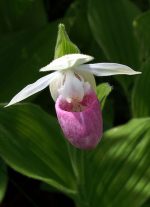 Also called pink and white lady’s slipper and queen’s lady’s slipper, this herbaceous perennial is a member of the orchid family, Orchidaceae. It is native to the northeastern quarter of the US where is grows in well drained soil in wet woods, swamps, and bogs. A rare plant, it is threatened or endagered throughout its range. Plants grow up to 35″ tall from a rhizomatous rootstock and have multiple hairy stems that carry 3-7 elliptical to ovate sessile leaves that are deeply ribbed, hairy and up to 8″ long. One to three flowers appear at the top of the stems in early summer and are 2-3″ wide. They have white sepals and petals with an inflated pouch that open on the top and is pink to rose depending on the climate. Under favorable conditions the plants may form large colonies of up to 50 stems. A pure white flowered variant exisits. The genus name, Cypripedium, comes from the Greek words Kypris referring to the island where Venus was worshiped, and pedilon, meaning slipper referring to the shape of the flower. The genus name, Cypripedium, comes from the Greek words Kypris refering to the island where Venus was worshiped, and pedilon, meaning slipper referring to the shape of the flower. The specific epithet, reginae, comes from the Latin word regina and means of the queen.
Also called pink and white lady’s slipper and queen’s lady’s slipper, this herbaceous perennial is a member of the orchid family, Orchidaceae. It is native to the northeastern quarter of the US where is grows in well drained soil in wet woods, swamps, and bogs. A rare plant, it is threatened or endagered throughout its range. Plants grow up to 35″ tall from a rhizomatous rootstock and have multiple hairy stems that carry 3-7 elliptical to ovate sessile leaves that are deeply ribbed, hairy and up to 8″ long. One to three flowers appear at the top of the stems in early summer and are 2-3″ wide. They have white sepals and petals with an inflated pouch that open on the top and is pink to rose depending on the climate. Under favorable conditions the plants may form large colonies of up to 50 stems. A pure white flowered variant exisits. The genus name, Cypripedium, comes from the Greek words Kypris referring to the island where Venus was worshiped, and pedilon, meaning slipper referring to the shape of the flower. The genus name, Cypripedium, comes from the Greek words Kypris refering to the island where Venus was worshiped, and pedilon, meaning slipper referring to the shape of the flower. The specific epithet, reginae, comes from the Latin word regina and means of the queen.
Type: Herbaceous perennial
Bloom: Terminal flowers with white petals and pink to rose pouch in early summer
Size: 1-3′ H x 1-3′ W
Light:Morning or afternoon sun (morning preferred)
Soil: Fertile, consistently moist, well-drained
Hardiness: Zones 4-6
Care: Very difficult to grow
Pests and Diseases: Slugs, snails
Propagation: Division
Companion Plants:Ferns, astilbe, beardless iris
Photo Credit: Orchi Wikimedia Commons